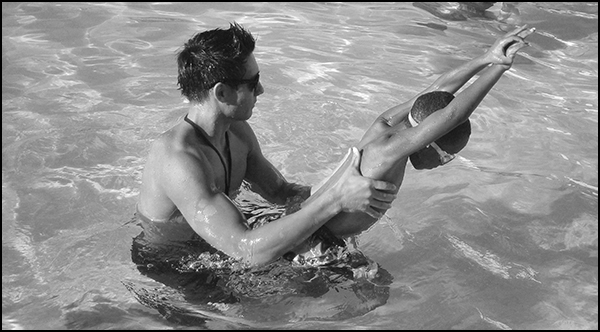49. Swimming Lessons and Presentations
Deconstruct and Reconstruct

To teach swimming, coaches take novices through the component skills in progressive stages. The first lesson takes place out of the water, at the side of the pool, where the novice learns the arm stroke and the leg stroke separately. Then the novice gets into the shallow end of the pool and practices the arm strokes and leg strokes, still separately, but now with training equipment—flotation devices, kickboards, and the rungs of a pool ladder—to develop the skills further. As the training progresses, the novice puts aside the equipment and swims, first in the shallow end of the pool, then the deep end, and finally, in a lake or ocean. The fundamental aspect of this approach is to deconstruct the basics and then to reconstruct them progressively. It works in swimming—as it does in all sports—and it works in presentations.
In the Power Presentations program, we teach delivery skills in progressive stages, in the same manner that swimming coaches teach swimming, an approach that produces an unexpected benefit for presenters in the development of their stories.
In the delivery skills session of the program, we begin the deconstruction by excluding slides. The initial impetus for this approach was twofold:
• To reduce the complexity of the exercises (like the swimming lesson on dry land)
• To reinforce the primacy of the presenter over the slide show
Just as swimming lessons involve multiple repetitions, so, too, do we ask our participants to repeat a short pitch several times. The unexpected benefit is that, as presenters develop their delivery skills, they also improve their narrative flow. The reason this occurs is also twofold:
• Verbalization, a practice technique you read about in Chapter 46, “Eight Presentations a Day,” creates familiarity and therefore fluency with the content.
• When presenters are freed from having to relate to their slides, they can concentrate more on their stories.
Slides, as they are conventionally designed today, hinder rather than help presenters. The all-too-common complexity of the slides forces presenters either to skim over them or, in the worst case, read them verbatim. This unholy alliance also fragments the narrative because each slide is discussed individually with no relationship to the next. When we exclude the slides in the practice, presenters focus on telling their story, connecting the dots, and creating a clear progression.
This is not to recommend that you eliminate slides completely. Given the deep entrenchment of PowerPoint in business today, that would be foolhardy. Instead, use simply designed slides that serve only to support your narrative.
In our coaching sessions, we ultimately bring the slides back into our exercises, the equivalent of putting the novice swimmer into the water. Then, having developed each component of each skill separately, a presenter can integrate all of them into a Power Presentation.
Here’s how you can use the deconstruction/reconstruction process to develop your presentation:
• First develop a clear and logical narrative.
• Then design slides to illustrate your narrative.
• Combine your story and slides in a verbal run-through of your presentation, but do it seated in front of your computer screen so that you don’t have to think about your eye contact, gestures, posture, or voice.
• Do another run-through standing up in a vacant conference room, presenting to the empty chairs as if they were occupied by audience members. This time, focus on your eye contact, gestures, posture, and voice.
• Do a dress rehearsal to colleagues or friends, integrating all the components.
• Dive into the water and swim like a fish.
